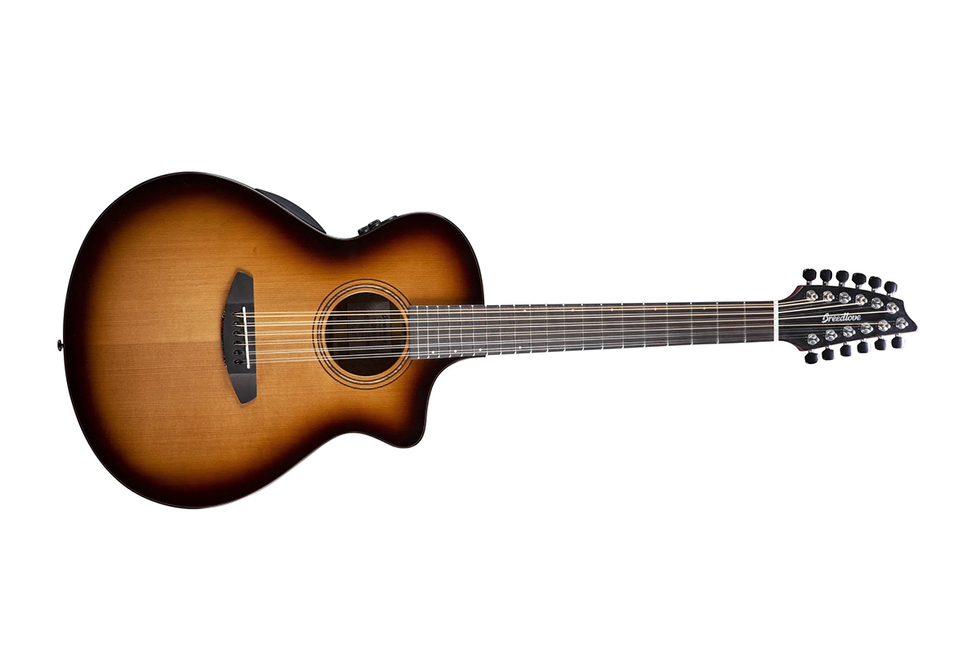Breedlove’s current site page for the Solo Pro Concert Edgeburst 12 CE takes an almost apologetic view of acoustic 12-strings. It’s funny. But it’s also hard to tell if they’re kidding or serious. I will put forth the notion, however, that acoustic 12-strings are nothing to apologize for. Acoustic 12-strings are awesome. They can be celestial or funky and earthy. Rhythm guitar powerhouse, mutant harpsichord, melody machine—decent acoustic 12-strings are all these things. Even trashed, cheap 12-strings will usually make cool sounds if you tune them right.
The China-built Breedlove Solo Pro Concert Edgeburst 12 CE reviewed here is a reasonably refined and affordable 12 that makes life easy on highly occasional 12-string players. It’s playable and has a lively, almost sunny voice and disposition. But its solid cedar top and solid mahogany back and sides also lend a sense of dust and duskiness that, at times, evokes affordable vintage 12-strings like the Gibson B-25-12. Indeed, there are a lot of sounds to find in this accessibly priced 12-string. One dimensional it is not.
Doubling Down
It’s easy to see why many players consider acoustic 12-strings a chore. There’s no shortage of 30-year-old beaters with boomerang neck relief that punish curious neophytes and send them fleeing forever. The 12 CE, though, feels pretty inviting. Action feels relatively low, yet each string rings with clear authority, even under the load of heavy strumming. Intonation is just about perfect, too, which makes the Breedlove sigh like a harp when you tune up and let a first-position chord ring. Tuning down a half- or full step, meanwhile, coaxes a lot of cool, growling low-mid overtones from the guitar without getting boomy or feeling flubby.
The 12 CE’s proportions also factor significantly into its agreeable ways. The concert orchestra-sized body is easy to snuggle. And that immediacy of feel is accompanied by an immediacy you hear via the side sound port. (Which also, incidentally, seems to highlight that vintage Gibson B-25-12 tonality). Other classically Breedlove design cues play their role in the player-friendly feel of the instrument. The company’s signature deep cutaway, for instance, gives you access to mandolin-like chords and tones on the highest six strings and at the highest frets.
Ring Those Bells
There’s a lot of physical balance in the 12 CE that’s mirrored in the tone palette, too. Though some of the guitar’s fast responsiveness could be attributable to Breedlove’s Cascade bracing pattern, I’d venture much of the magic is in the guitar’s red cedar and mahogany tonewood combo. Breedlove isn’t the only builder to employ this elegant looking and sounding wood duo. It shows up on a few guitars in this low-mid price class. But Breedlove uses it especially well here. The cedar top feels simultaneously reactive, grounded, and, once again, earthy. It also adds just enough top end sparkle to offset the mellower tonalities of the mahogany back and sides. The resulting tone sum makes the 12 CE feel responsive to fingerpicking (though it takes a strong thumb to completely offset the chiming resonance of the high B and E string pairs).
Tuning down a half- or full step, meanwhile, coaxes a lot of cool, growling low-mid overtones from the guitar without getting boomy or feeling flubby.
Construction, by the way, reveals a careful hand all around. A wider neck like this could be made a miserable experience by rough frets, but they are perfectly shaped at the ends. The root beer hues of the finish give the small body an extra sense of dimensionality and luxury. And though the side port gives you a clear and potentially unflattering look at the 12 CE’s innards, every bit of bracing you do see looks carefully carved, sanded, and glued. (The sound port, by the way, comes with a fitted rubber feedback reduction insert that works great in amplified situations.)
Styling, as with many Breedloves, will probably be the most polarizing aspect of this guitar. It’s a modern flattop, to be certain. But it’s funny how the Breedlove headstock has evolved slowly into a familiar, almost institutional, shape in acoustic circles. And its slim proportions make it a graceful fit for the compact proportions of the body.
The Verdict
Though 1200 bones is considerable money for an import flattop, the quality construction, agreeable playability, and many sweet tones make it feel like a pretty fair deal. Like any good 12-string that you don’t have to fight too much, it can guide you away from ruts, encourage and stimulate an arrangement-oriented musical mindset, and perhaps unshackle your inner Jimmy Page or Jeff Lynne in the process. And while the 12 CE’s contemporary styling might divide opinion, for those that play it, its ability to open different musical avenues won’t find many detractors.
Breedlove Organic Solo Pro Concert Edgeburst 12 CE Demo | First Look
Breedlove Organic Solo Pro Concert CE 12-string Acoustic-electric Guitar - Edgeburst
















